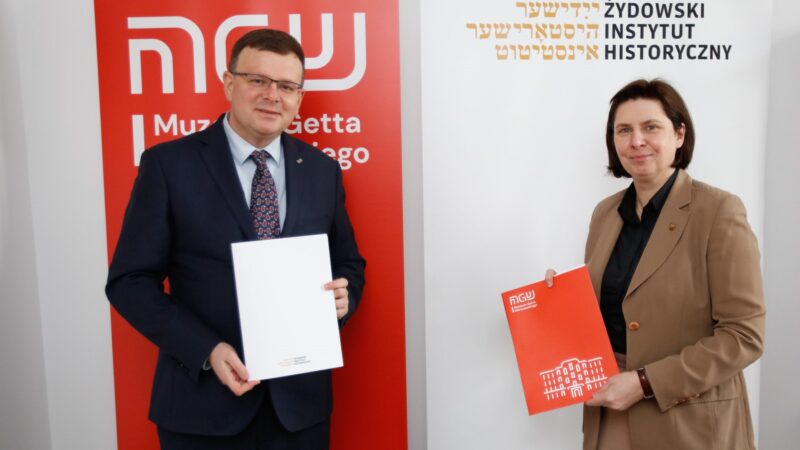Cooperation agreement between the Jewish Historical Institute and the Warsaw Ghetto Museum
On Friday, March 12, Monika Krawczyk, director of the Emanuel Ringelblum Jewish Historical Institute in Warsaw, and Albert Stankowski, director of the Warsaw Ghetto Museum, signed a cooperation agreement between both institutions.
Cooperation agreement
The most important areas indicated in the agreement involve cooperation in the field of exhibitions, education, acquisition, securing and sharing of collections, broadly understood scientific activity, including the organization of conferences and seminars, as well as publishing projects and reciprocal promotion.
Both institutions also announced the exchange of their experiences and mutual support in the work on the development of their arrangement.
– Monika Krawczyk – “Director of the Emanuel Ringelblum Jewish Historical Institute: “We are glad that the newly created museum joins the network of institutions cooperating with the Jewish Historical Institute, such as the POLIN Museum of the History of Polish Jews, Memorial de la Shoah in Paris, the Holocaust Museum in Washington and the YIVO Institute in New York. This is particularly important considering the fact that the idea of the Warsaw Ghetto Museum was created a few years ago within the walls of the Jewish Historical Institute. We have a common goal of disseminating knowledge and protecting the memory of Polish Jews.”
– Albert Stankowski – “Director of the Warsaw Ghetto Museum: “The Emanuel Ringelblum Jewish Historical Institute – as the oldest institution researching the history of Polish Jews – is for us, one of the youngest museums preparing an exhibition devoted to the extermination of Jews, a key partner in our activities. The agreement signed today is the first step towards substantive cooperation also in the creation of our permanent exhibition. The collections of the Jewish Historical Institute are invaluable for the purpose of presenting the history of the Warsaw Ghetto. The first part of the Ringelblum Archive, found after the war, was deposited in the building of the Bersohn and Bauman Hospital for Children – where at that time the Central Committee of Polish Jews had its seat. In the near future, a permanent exhibition of the Warsaw Ghetto Museum will open there.”
Emanuel Ringelblum Jewish Historical Institute (JHI) is one of the world’s most important research and development institutions dealing with the history of Jews. It was here, on Tłomackie Street, that research on the Holocaust began in 1947. The greatest treasure that the JHI looks after is the Underground Archive of the Warsaw Ghetto, the so-called Ringelblum Archive, part of the UNESCO “Memory of the World” list as a world heritage monument. Since 2017, the documents from the Archive are presented at the permanent exhibition “What we’ve been unable to shout out to the world”. The
The Warsaw Ghetto Museum (WGM) is a state institution of culture established in March 2018 by the Minister of Culture, National Heritage and Sports. It is an institution in process of organization, whose aim is to disseminate knowledge about the history of the Warsaw Ghetto and other ghettos established by the Germans during World War II throughout occupied Poland. The permanent exhibition of the Warsaw Ghetto Museum will be located in the historic building of the former Bersohn and Bauman Hospital for Children. The museum is currently running a campaign entitled “We Collect, Build, Remember”, the aim of which is to acquire objects for its permanent exhibition. Under similar agreements, the WGM cooperates, inter alia, with the Museum in Treblinka, the Warsaw Uprising Museum, the Social and Cultural Society of Jews in Poland, the Museum at Majdanek, the Institute of National Remembrance and the Nissenbaum Family Foundation.
Photo: Grzegorz Kwolek, JHI.


